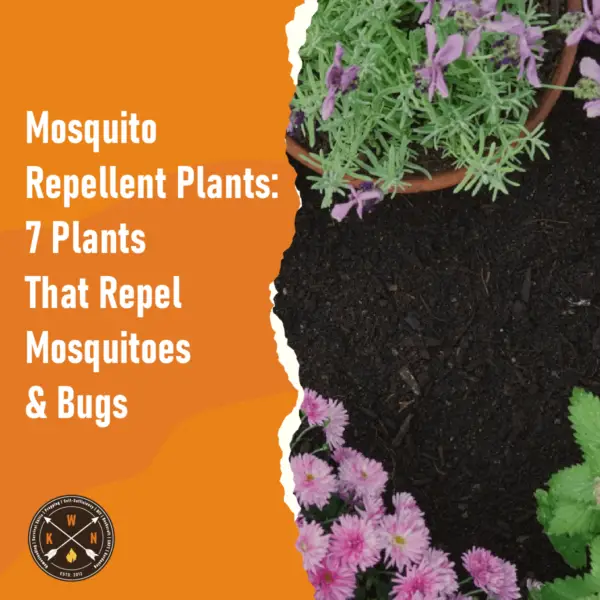
As well as the plants that repel mosquitoes, we’ve also included a few plants repel mosquitoes AND some other insects such as gnats, ticks & fleas (and other bugs); and plants that protect other plants from aphids & mites etc.
Planting and growing insect and mosquito repellent plants provide a great opportunity to get out in the garden and plant some plants which are a perfect mix of beauty and functionality. Some people are sceptical about using plants to repel bugs/insects, whilst others are 100% convinced that mosquito repellent plants do as advertized. My advice is – nothing is going to be as effective as DEET and similar pharmaceutical products, but these plants that repel mosquitoes and other bugs really do help. Many of them a beautiful in their own right, and some also have other useful properties.
The thing is – if you take natural plant based bug repellents out of the equation; the only really option is DEET based products. There are serious health concerns about the toxic effects of DEET as it is absorbed into the body through your skin. Children are thought to be most at risk from side effects, as children’s skin absorbs more DEET than an adult’s. Sure, DEET has its place and it is even vital in certain situations and locations, but I think it is always worthwhile to also consider natural cures and solutions rather than just reaching for the pharmaceutical option each and every time.
At the end of the day, if you plant some of the mosquito and bug repellent plants listed below, at the very least you’ll be getting some pretty plants that smell beautiful. If however you are still not convinced enough to plant any of these plants that repel mosquitoes and other biting insects, why not check out: All Terrain Herbal Armor DEET-Free Natural Insect Repellent, it is biodegradable, cruelty – free, and contains no petrochemicals or animal by products.
Table of Contents
TogglePlants That Repel Mosquitoes
Here is infographic with the keypoints, see down below for more in-depth information on each plant.

The following plants are known throughout the world to act as natural mosquito repellents. While some work better than others, incorporating these plants into your yard can reduce the concentration of these annoying, and potentially dangerous, insects. So without further ado, here’s our list of the best mosquito repellent plants.
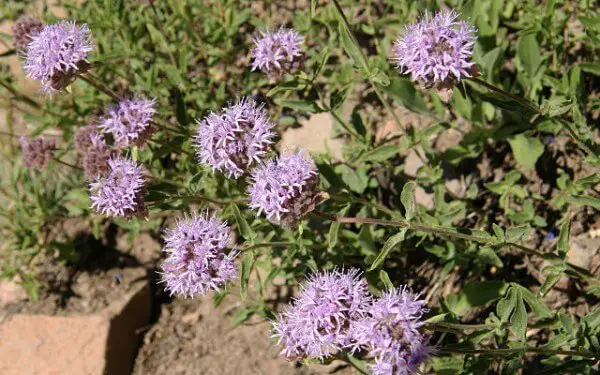 Pennyroyal – one of the most versatile mosquito repellent plants to grow
Pennyroyal – one of the most versatile mosquito repellent plants to grow
Pennyroyal
Pennyroyal helps to repel mosquitoes, gnats and also ticks and fleas! In fact it should be your number one natural mosquito repellent plant to grow.
Pennyroyal is often used in commercial natural mosquito repellent creams and sprays. Pennyroyal is one of the best bug repellent plants in the garden, but it is best utilized as a natural mosquito repellent applied to the skin.
If you crush pennyroyal leaves and rub them onto your skin, this acts as an effective natural mosquito repellent. Additionally, you can also crush the stems and put them in pockets, bags and hats.
Natural mosquito repellent for dogs! Crushed pennyroyal leaves and stems can also be rubbed on dogs to help repel ticks and fleas. Actually you will often see dogs rubbing in pennyroyal patches when outdoors.
The most effective way to incorporate pennyroyal into your yard is to establish it as a companion plant. Many find success planting pennyroyal close to areas where they congregate. For example, planting near patios and outdoor seating areas. Pennyroyals do exceptionally well when potted. To prevent common fungal diseases that afflict this plant, spray with cooled chamomile tea after planting.
 Feverfew is beautiful in its own right AND it’s a natural mosquito repellent too!
Feverfew is beautiful in its own right AND it’s a natural mosquito repellent too!
Feverfew
Feverfew is great for repelling mosquitoes and other flying biting insects. It is ideal for planting around outdoor seating areas, pathways and close to doorways and windows; for maximum benefit, plant in conjunction with citronella grass and lavender (see below). Double up with these plants that repel mosquitos etc, for maximum results.
In addition to its natural insect repellent qualities, feverfew also has many medicinal uses. It is historically used to help treat nervous disorders, headaches and it also works as a laxative and helps ease bloating.
To enhance its mosquito repelling qualities, it’s suggested to plant feverfew near outdoor seating and congregating areas in your yard. For example, plant around pathways and close to windows and doorways. If you have issues with mosquitoes entering your home, plant feverfew outside and indoors near windows.
Unlike some of the other mosquito repellent plants, feverfew is quite hardy and does quite well in a wide variety of light and soil conditions. If you’re starting plants indoors, it’s best to group 3 or 4 seeds together in 1/4-inch deep soil. Don’t bury seeds deep in the soil, as this plant is light dependent to spark germination and growth. It’s safe to transplant after the first true leaves have grown. Make sure to give feverfew around 8 to 12-inches of space between other plants. Again, this is one of the best bug repellent plants to grow in your garden.
To take advantage of its medicinal uses, harvest flowers when they’re in full bloom and harvest leaves just before the plant starts to flower. Harvesting at these times ensures the maximum concentration of medicinal compounds.
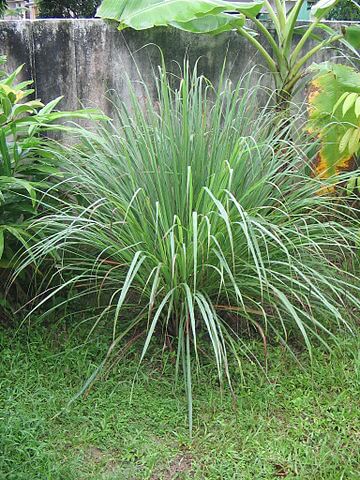 Citronella grass – a versatile natural insect repellent
Citronella grass – a versatile natural insect repellent
Citronella grass
Citronella grass is an old favourite; everyone knows it is commonly used as an insect and natural mosquito repellent in outdoor candles, which are used around outdoor eating and seating areas. Citronella grass is one of the best mosquito repellent plants and it can be planted and used in a similar way as citronella candles, to keep flying insects away.
Belonging to the geranium plant family, the fragrance produced by the citronella foliage is known as one of the most effective natural mosquito repellents, which is why it is often found in DEET free natural mosquito repellents. While some proponents claim that by simply growing the plant repels mosquitoes, the actual results are mixed. The bug repelling fragrance produced by its leaves seems to primarily work when the leaves are crushed. Unlike other plants that repel mosquitoes in this list, to maximize your results, you have to do a little extra work.
Once the plant has matured, remove several of its leaves. Using your hands, rub the leaves together to crush them and release its essential oils. Rub these oils over your body. For added relief from these bothersome pests, sprinkle crushed citronella leaves around your outdoor seating area.
To further maximize the insect repelling results, plant citronella grass in your garden & yard and use in conjunction with feverfew and lavender.
Perhaps one of the greatest benefits of citronella grass is its ease. Unlike other bug repellent plants, citronella is quite hearty and capable of being grown in a wide variety of climates. Because of its versatility it can be grown indoors and outdoors. While the plant thrives outdoors during warmer months, make sure to transplant it to indoor locations before the first frost.
Citronella prefers a minimum of six hours of sunlight per day – this is regardless of its indoor or outdoor location. While full-sun is preferred, they can tolerate partial shade. Citronella may thrive in a variety of soils, as long as it’s well-drained. To maximize the production of mosquito-repelling oils, occasionally fertilize with all-purpose plant food.
On average, a citronella plant can grow anywhere from 2 to 4 feet high. To encourage new growth, pruning and pinching is highly recommended.
Additionally, citronella grass has also been found to have a calming effect on barking dogs, which is worth considering if you have a dog which barks excessively day and night. Your neighbours might thank you for at least giving it a try!
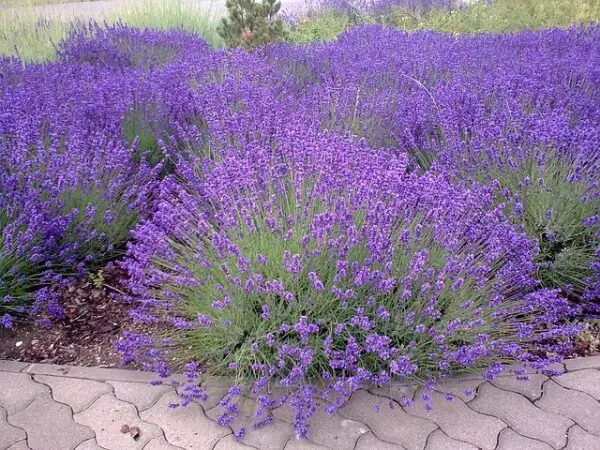 Beautiful! I’d still grow lavender even if it didn’t repel mosquitoes
Beautiful! I’d still grow lavender even if it didn’t repel mosquitoes
Lavender
Belonging to the mint family, lavender is a fragrant herb native to the Mediterranean region. Producing beautiful blue-violet flowers, the oils it creates have a long history being used as a medicinal tincture.
Due to its calming scent, lavender oil is most commonly used as a tension-relief and anti-anxiety remedy. Although its uses in the human body are varied, one of its most potent uses is also one of the most under-rated.
Lavender is a powerful mosquito and general insect repellent. The oils secreted by this plant effectively ward off these pests through completely natural means. There are several ways you can use lavender to naturally repel mosquitoes. The most effective of these methods is by extracting its oils. To utilize this method, simply grind its flowers and apply to the areas of your skin where mosquitoes like to bite, such as your ankles and arms.
Of course, lavender naturally repels mosquitoes by simply growing. Plant lavender around outdoor seating areas, pathways and near doorways and windows. The scent produced by the plant wards off mosquitoes and other bugs. Lavender can be successfully grown indoors and outdoors. Along with its powerful anti-mosquito properties, it’s also a beautiful addition to any home or garden.
Cut and or dried lavender can also be placed on windowsills to stop mosquitoes entering the house. Additionally, dried lavender flowers can also be used in wardrobes to repel moths and keep clothes smelling fresh. All in all lavender is one of the most versatile plants that repel mosquitoes, that you can grow.
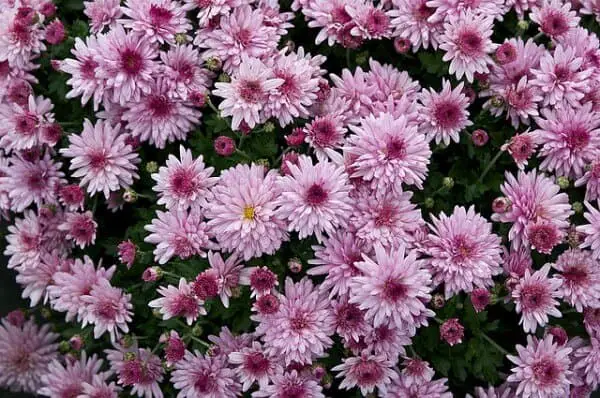 Pyrethrum Chrysanthemum repels aphids, leafhoppers, mites and other bugs that attack plants
Pyrethrum Chrysanthemum repels aphids, leafhoppers, mites and other bugs that attack plants
Pyrethrum also known as Chrysanthemum
Whilst not specifically a mosquito repellent plant, pyrethrum helps to repel a whole host of other insects and bugs, including: aphids, leafhoppers, spider mites, harlequin bugs and ticks.
Pyrethrum is best used as a ‘companion plant’ to protect other plants with its insect repellent properties. It is planted close to plants which are affected by the insects above.
Additionally a natural pesticide can be made with pyrethrum flowers. The flowers need to be dried and crushed and mixed with water. It is beyond the scope of this article to give specific instructions on potency etc., so please carry out further research before trying this, as even though the pesticide is completely natural, it can still be harmful to humans in certain situations.
The oils produced by the Chrysanthemum plant is one of the most powerful natural bug repellents. In fact, the majority of all-natural repellents call upon its essential oil as its primary active ingredient. Not only does its oil repel mosquitoes, but if they come in contact with it the oils, it actually kills the insect. This is an excellent benefit for those dealing with massive mosquito infestations.
As with many of these plants, Chrysanthemums are relatively easy bug repellent plants to care for, as long as you follow several tips. This plant is particularly susceptible to mildew. Therefore, it’s imperative to keep them as dry as possible. They require ample air circulation, water draining and full morning sun to efficiently dry any dew that’s been deposited on its stems and leaves. Never plant in low-lying or boxed-in areas that feature little air circulation.
As for the soil, these plants require fertile, sandy or loamy soil. To ensure maximum health, make sure the soil maintains a pH level around 6.5. These plants are relatively tough and are able to thrive without much external fertilization. In order to keep these plants as healthy as possible, make sure they’re exposed to light. During the growing season, feed with a balanced, all-purpose fertilizer.
 Marigolds – the jack of all trades
Marigolds – the jack of all trades
Marigolds
Marigolds are beautify, strongly aromatic herbaceous flowers commonly found throughout the world. While many choose to cultivate these flowers based upon their season-long blooms and delicious scent, these flowers are also effective mosquito repellents.
As with pyrethrum, marigolds are best used as a ‘companion plant’ to help protect other plants; however, marigolds do also have some natural mosquito repellent properties, so it’s a bit of an all-rounder.
Marigolds contain a chemical compound called thiopenes in the roots. This plant repels aphids, cabbage maggots, white flies and many other pests. Marigolds are particularly good at protecting tomato plants.
Along with its potent anti-mosquito properties, marigolds are relatively easy to grow. Although easy to care for, there are several tips you should follow to ensure maximum growth. The first rule of thumb to remember is marigolds require lots of direct sunlight. Although they can flourish is almost any type of soil, these flowers tend to do best in well-drained, moderately fertile soil. As spring warms the soil, sow them directly into the garden. If you’re growing from seeds, starts the seeds indoors around 4 to 6 weeks before the last spring frost. When seedlings grow to around 2-inches tall, separate them and plant in flats of loose soil. You may also transplant them into a garden.
Once planted, marigolds require very little upkeep. Never water marigolds from overhead. Rather, water at the base of the flowers. Don’t worry about fertilizing these plants. Due to its sensitive nature, excess fertilization causes the foliage to rapidly develop, which reduces flower production. Unlike other plants, marigolds flower best in poor soil. Try to plant these flowers in full-sun as they can mildew quickly if the flowers remain damp from morning dew or rainstorms.
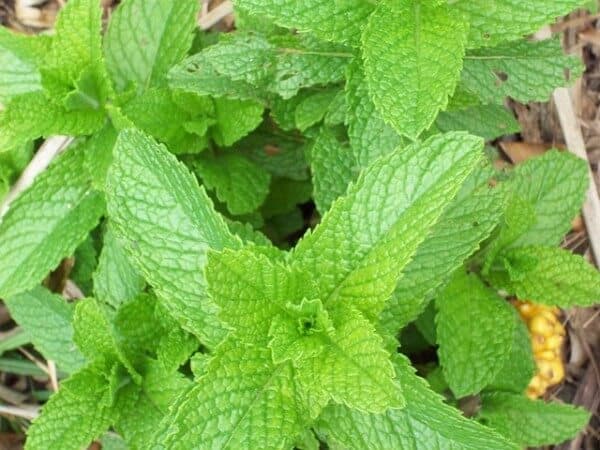 Everyone should grow peppermint, for cooking if nothing else
Everyone should grow peppermint, for cooking if nothing else
Peppermint
Peppermint is one of the most beloved plants due to its strong, poignant scent. A common ingredient in a vast array of products, the peppermint plant does far more than simply add a delicious flavor to treats or toothpaste.
The majority of bugs despise the scent and taste of peppermint. Its strong essential oils waft effortlessly through the air to naturally repel mosquitoes and other common insects. Planting peppermint along outdoor seating areas, around windows or near doorways is an effective way to naturally repel mosquitos and other bugs.
Another added benefit? Should you be bitten by a mosquito, rubbing its leaves directly into the the bite offers near-instant itch relief. Double benefit! It’s a plant that repels mosquitoes and it provides mosquito bite relief.
An excellent benefit of growing peppermint is its ease. As with any other plant belonging to the mint family, peppermint is fast growing and requires minimal care. When growing peppermint outdoors, plant about 2-feet apart in moist soil. This plant spreads quite rapidly and requires a decent amount of room to flourish. At its peak, peppermint grows around 1 to 2-feet tall.
In your garden, plant peppermint near tomatoes and cabbage to thwart pesky insects. While these plants tend to do best directly in a garden, they also do quite well in pots. Fill a container with compost-enriched potting mix and place close to outdoor seating areas. The only requirement is these plants require full sunlight to truly flourish.
Unlike other plants in this list, peppermint does best in moist soil. When planting outside, use a light mulch to help keep the soil moist. Water the leaves regularly to keep them clean and to maintain high oil production. When growing peppermint indoors, make sure to water them regularly. Focus on maintaining even soil moistness.
To enhance the mosquito-repelling effectiveness of peppermint, pick several mature leaves from the plant. Mince the leaves into tiny pieces and scatter across your entire outdoor sitting area. Many perform this action immediately before holding an outdoor party or enjoying a nice glass of wine and a book. While the plant itself will help repel mosquitoes, by mincing the leaves and spreading them, the oils are released in greater concentrations. Consider rubbing a little of the minced leaves across areas of your skin where mosquitoes like to bite. However, be careful when doing this. If you have sensitive skin, the oils can cause a rash or irritation. Test on a small portion of your skin and wait 20 minutes. If no reaction occurs, apply to a larger area.
Mosquitoes | An Overview of Blood-Thirsty Pests
Did you know there are over 3,000 different mosquito species throughout the world? While each mosquito has a unique scientific name, their presence to humans and animals is relatively similar. As with most insects, mosquitoes lay eggs to reproduce. These eggs are often found in still, calm waters and float on “rafts.” One of the greatest preventative measures is to eliminate water accumulation in your yard.
There are four stages a mosquito goes through: egg, larva, pupa and adult. During the egg, larvae and pupae stage, the mosquitoes live in water. However, as they molt into the adult stage, they fly away from water sources and become airborne. As summer temperatures rise to 80-degrees Fahrenheit, the larva goes through a rapid transformation. On average, it takes four days for larva to reach the pupae stage. From here, it takes an additional three days before the pupa transforms into an adult mosquito. The lifespan of a single mosquito is relatively short. Female mosquitoes may live for several weeks if they have a constant source of sugar while male mosquitoes typically live for less than a week.
The primary difference between adult male and female mosquitoes is its size. Generally, female mosquitoes are larger than males and have a threadlike antennae. Male mosquitoes feature a more bushy antennae.
Unlike popular belief, mosquitoes find nourishment on more than just blood. Both male and female adult mosquitoes feed on nectar. However, when it comes time to lay eggs, female mosquitoes seek out warm-blooded hosts to feed on their blood. Male mosquitoes don’t feed on blood.
The Importance of Mosquitoes in the Ecosystem
It’s difficult to imagine these annoying pests have any purpose outside of ruining your outdoor enjoyment, but they have several important purposes in your local ecosystem. Mosquito larvae serves as a viable food source for fish and other aquatic animals. As the mosquitoes grow older, they become an important food source for bats, birds, spiders, dragonflies and other arthropods. Without these insects, entire animal groups would lack in nourishment.
The Negative Impact of Mosquitoes
Of course, with a positive benefit comes a negative. Perhaps the most noteworthy downside of mosquitoes is their ability to transmit dangerous pathogens to humans and other warm-blooded animals. Mosquitoes can transmit diseases, such as encephalitis, dengue fever and yellow fever. It’s important to note these insects can only be carriers of disease, they cannot spontaneously cause disease. For example, a mosquito must feed on an infected host in order to transmit a pathogen.




